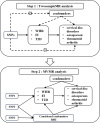Causal Relationships Between Abdominal Obesity, Type 2 Diabetes, Fasting Insulin, and Cervical Disc Disorders, Osteoporosis, and Rheumatoid Arthritis: A Mendelian Randomization Study
- PMID: 40809852
- PMCID: PMC12345940
- DOI: 10.2147/JMDH.S529217
Causal Relationships Between Abdominal Obesity, Type 2 Diabetes, Fasting Insulin, and Cervical Disc Disorders, Osteoporosis, and Rheumatoid Arthritis: A Mendelian Randomization Study
Abstract
Background: Evidence from prior research indicates a connection between orthopedic diseases and metabolic disorders, including type 2 diabetes (T2D), insulin resistance, and abdominal obesity. However, the causal relationships remain uncertain. This study utilized Mendelian randomization (MR) to investigate the causal effects of abdominal obesity, T2D, and fasting insulin (FI) on cervical disc disorders, osteoporosis (OP), and rheumatoid arthritis (RA).
Methods: Exposure data were sourced from genome-wide association studies (GWAS) for waist-hip ratio (WHR), body mass index (BMI), FI, and T2D with a sample size of 697,734 participants for WHR, 151,013 for BMI, and 62,892 cases with 596,424 controls for FI and T2D. Outcome data were derived from FinnGen, including cervical disc disorders (14,670 cases and 294,770 controls), OP (8,017 cases and 391,037 controls), and RA (13,621 cases and 262,844 controls). Univariate Mendelian randomization (UVMR) was performed using the inverse-variance weighted (IVW), MR-Egger, and weighted median methods. Multivariate Mendelian randomization (MVMR) included BMI as an adjustment. Sensitivity analyses incorporated Cochran's Q test, the MR-Egger intercept test, and leave-one-out analysis.
Results: UVMR identified WHR as a risk factor for cervical disc disorders (odds ratio [OR] = 1.147) and RA (OR = 1.260). FI increased the risk of cervical disc disorders (OR = 1.534), while T2D elevated the risk of RA (OR = 1.260) but lowered the risk of OP (OR = 0.925). MVMR confirmed FI's positive association with cervical disc disorders (OR = 1.716), T2D's increased risk for RA (OR = 1.062), and its protective role against OP (OR = 0.912). WHR remained a significant risk factor for RA (OR = 1.203).
Conclusion: Genetically predicted WHR and T2D were associated with an increased risk of RA. Additionally, T2D and FI increased the risk of cervical disc disorders, while T2D was found to have a protective role against OP. These findings provide novel insights into the interplay between metabolic factors and prevalent orthopedic conditions, offering valuable implications for clinical decision-making and targeted disease management strategies.
Keywords: Mendelian randomization; abdominal obesity; cervical disc disorders; fasting insulin; osteoporosis; rheumatoid arthritis; type 2 diabetes.
© 2025 Tang et al.
Conflict of interest statement
The authors declare no competing interests in this work.
Figures
References
LinkOut - more resources
Full Text Sources
Miscellaneous





